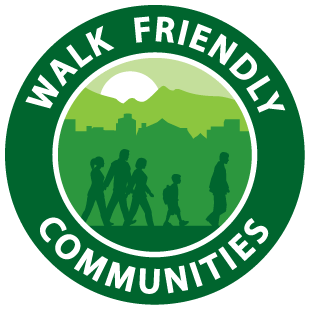 The Walk Friendly Communities program, now celebrating its tenth year with support from FedEx, recognizes cities throughout the United States for high levels of commitment to pedestrian safety. The program works to encourage walkable cities and towns by raising awareness of those who are promoting walkability and by educating decision-makers through resources and detailed feedback.
The Walk Friendly Communities program, now celebrating its tenth year with support from FedEx, recognizes cities throughout the United States for high levels of commitment to pedestrian safety. The program works to encourage walkable cities and towns by raising awareness of those who are promoting walkability and by educating decision-makers through resources and detailed feedback.
A Walk Friendly Communities designation is recognition for cities and towns in the US that are prioritizing pedestrians in the way they plan and design their transportation networks. These communities use policy actions and planning frameworks to lay out a strategy for improving the walking environment; invest resources in designing and building streets that maximize pedestrian safety and comfort, and deliver education and encouragement programs that reinforce the benefits of walking. Through a comprehensive application process, cities and towns that apply for the program are evaluated by experts in pedestrian planning and design. Those communities who excel in creating safe and walkable transportation networks are recognized as Walk Friendly Communities and held up as examples for other cities and towns to follow.
Since 2010, the program has designated 74 cities and towns in 31 states as Walk Friendly Communities. With support from FedEx, the program is entering its tenth year and continues to provide technical assistance and inspiration to communities around the country. In that time over 200 communities have applied for a Walk Friendly Communities designation.
Creating Safe, Walkable Environments in Walk Friendly Communities
Creating safe, appealing walking environments means addressing pedestrian needs in multiple areas and integrating these strategies comprehensively into community decision making. A majority of Walk Friendly Communities have standalone pedestrian plans and have implemented a Complete Streets policies or program. Many have committed to Vision Zero.
Most importantly, Walk Friendly Communities are tangibly advancing their transportation systems for pedestrians, and the outcomes are measurable. While data on infrastructure are not standardized, we are able to track US Census reported pedestrian commuter proportions and collect pedestrian crash and fatality data at the city level.
The Walk Friendly Communities team recently completed an examination of safety outcomes in Walk Friendly Communities in comparison to a sample of peer cities that have not been designated as Walk Friendly. We sought to understand whether our designated communities were meeting two primary goals of the program: increasing levels of walking while also improving safety for those who are walking.

In Walk Friendly Communities, more people are walking to work, compared to communities that are not designated Walk Friendly and compared to the national average. More complete, comfortable walking environments encourage people to make their commute by walking; however, even with greater numbers of people walking, pedestrian fatality rates in Walk Friendly Communities are demonstrably lower than those in peer cities. Not only are these overall rates considerably different but Walk Friendly Communities have steadily improved their safety record over time, while fatality rates in peer cities are increasing.
Select program highlights
The Walk Friendly Communities pool of designees boasts a great number of stellar examples of how communities can improve conditions for walking. Here are a select few examples:
Arlington, VA: Pedestrian and Bicycle Count Program
Arlington County has extensive pedestrian (and bicycle) data collection activities. The data are used for planning, engineering, and operations, as well as education, outreach, marketing, and research. The Bicycle and Pedestrian program in the Transportation Planning Bureau manages an in-house network of permanent and portable automatic continuous pedestrian and bicycle counters. There are currently 38 automated counters that detect and separately record bicycle and pedestrian trips. These counts are shared publicly through an online, map-based display.
San Francisco Vision Zero Program
San Francisco has a long history of supporting pedestrian-focused investments through policy action, including the 2011 Walk First program. The latest Vision Zero Action Strategy renews the City’s focus on walking and lays out aggressive steps to improve safety, address equity, combat climate change, and increase the share of trips taken by sustainable modes to 80 percent.
Seattle, WA: Pedestrian Mobility around Construction Zones
One of the many great initiatives to emerge from Seattle’s Vision Zero effort is a rule for Pedestrian Mobility around Construction Zones, which outlines requirements for developers and contractors whose work impacts the public right of way.
Columbus, OH: Neighborhood Level Planning
Columbus is a city that has historically promoted walkable development on a district level. Columbus’ recently established Department of Neighborhoods boasts 40+ neighborhood plans that focus on walking and transit. The city also offers a large number downloadable local walking maps to encourage more trips to be made by foot.
City of Portsmouth, NH: Complete Streets
The city of 20,0000 has an impressive approach to Complete Streets, anchored by numerous policies that drive the City’s investment in bicycling and walking. The Complete Streets policy is supported by a set of Design Guidelines that help incorporate pedestrian needs into every transportation project.
Minneapolis, MN: Sidewalk Repair Program
Minneapolis’s extensive sidewalk network is an example of how the City is devoted to providing pedestrian facilities. Sidewalks on both sides of the street are considered ‘standard infrastructure’, and currently 92 percent of streets have sidewalks on both sides. The City’s Sidewalk Inspections Office conducts an annual sidewalk and curb ramp repair program that replaces any defective sidewalks and curb ramps on a regular basis.
Fort Collins, CO: Bus Stop Design Guide
A Bus Stop Design Standards & Guidelines document assists city staff, developers, local partners, and private property owners improve street and curbside characteristics for transit stops.
